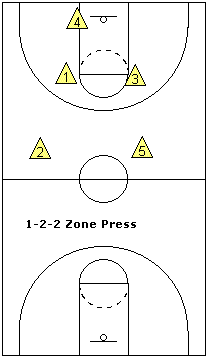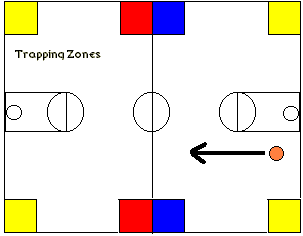Basketball Defense – 1-2-1-1 Diamond Full-Court Zone Press Defense
By Dr. James Gels, From the Coach’s Clipboard Basketball Playbook"Helping coaches coach better..."
Disclosure: This page contains affiliate links, which means that Coach's Clipboard receives a small commission (at no cost to you) if you make a purchase using these links.

The 1-2-1-1 zone press pressures the inbounds passer, and attempts to trap the first pass receiver. You can call either "one fist" or "two fist" options from the bench to change your strategy a little, and confuse the opponent.

With one-fist and two-fist, always try to deny a center inbounds pass... force (allow) the pass to the corner. O4 overplays the inbounder toward the middle to help deny the center pass.
To trap the offensive player in the corner, or along the sideline, the first defender (X1) moves over quickly to stop the ball and seals off the sideline so the offensive player cannot dribble up the sideline. On the inbounds pass, X4 quickly sprints above the ball up the lane line (to prevent the dribble to the middle) and then closes in on the trap from there. The other defenders must play in the gaps between the passing lanes, and try to deny or intercept the pass. We will always have two trappers, two interceptors, and a safety (or goalie)."One-Fist"
X4 and X1 (or X3) immediately trap the first pass."Two Fist"
X4 and X1 (or X3) wait until the first pass receiver puts the ball on the floor and starts the dribble, and then quickly close in and trap. In this situation, you are waiting for the pass receiver to first commit with the dribble. Once you set the trap, he/she has lost the option to dribble."Side Fist"
Call "side fist" to signal your players to trap the ball handler along the sideline, either in the back-court, or the front-court.Adjustment, changing to a 1-2-2 zone press.
The 1-2-1-1 diamond press is vulnerable up the sidelines. If the opponent is beating your press up the sidelines, then you can adjust your defense to a 1-2-2 zone press. X2 and X5 stop the sideline passing and dribble penetration.
Of course, this press is a gamble and makes you more susceptible to getting beat long for a lay-up. Have a rule that if one offensive player goes long, then the mid-court weak-side defender (opposite the ball) will move back to prevent the long pass. For example, if the ball is on the offense's right side (X1's side), or in the center, and a player goes long, then X5 should drop back. If the ball is on the offense's left side (X3's side), then X2 drops back.
Some basic principles apply to all presses
1. Always have one player back in prevent mode to prevent the easy lay-up.2. Sprint back to the paint when you are beaten.
3. When trapping, or trying to stop the dribbler, don't reach in! Rather, you must move your feet to get into position and deny the sideline. The referee is watching closely for the reach-in foul. Back-court fouls are usually "stupid" fouls, created when the opponent was not even in position to score. It's especially "stupid" if the opponent is in the two-shot bonus, or if it is committed with only seconds remaining in a period.
4. Trapping
In trapping, one defender should first stop the dribbler, often along the sideline or baseline, or in one of the "trapping zones" (see below). Trapping zones are those areas where the offensive player definitely does not want to get caught losing the dribble. It's like getting caught in a corner.
Once the ball is stopped, the second defender sprints over and double-teams the ball. They cut off the ball-handler's view, and get into the passing lane. The position of their hands should be at the same height as the ball. If the offensive player holds the ball high to "throw over the top", the hands should be high. If the ball is low, the hands should be low to prevent the bounce pass.
Do not reach in! This only transforms a good situation into a bad one (now the player goes to the free throw line). Instead, the defenders should deny the offensive player from getting the pass off and get the 5-second call, or try to tip the pass, or force her to make a bad pass, which is intercepted by one of your teammates.
5. Gapping (zone press)
The other defenders who are not actively trapping, try to get into the gaps between the ball-handler and his teammates. They play the passing lanes and deny and intercept passes from the trapped player.
6. If the opponent is successful in running a fast-break, your "prevent" guard may have a 2-on-1, or 3-on-1 situation, being the only defender back. In this situation, the prevent defender should be taught to first prevent the lay-up. If the opponent chooses to shoot the outside jumper, give it to them, as it is a lower percentage shot than the lay-up, you avoid getting a foul, and you may get the rebound, or delay the offense long enough for your teammates to arrive on defense.
Often I see high school players make the mistake of coming up away from the basket and challenging the ball, only to get beaten by an easy pass to another player under the basket for a lay-up. Again, the defender must stay back and "gap" the offensive players, that is, try to straddle and cut off the passing lanes to the easy lay-up.
Trapping Zones
The yellow zones catch the player in the corner.The red zones are excellent trapping zones, since the offensive player cannot retreat across the 10 second line.
The blue zones are good trapping zones because the offense has to worry about the 10-second count.
